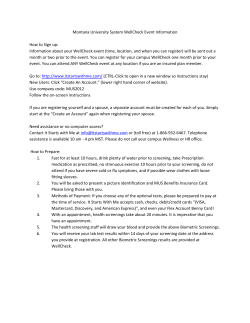
We “know” it works…so why doesn’t it work?
We “know” it works…so why doesn’t it work? The limits of screening and treatment for latent TB as a TB control strategy Kevin Schwartzman MD, MPH Respiratory Division, and McGill International Tuberculosis Centre McGill University Montreal, Quebec, Canada 18th NAR--IUATLD Annual Conference Boston, MA, USA March 1, 2014 Disclosures • I hold research grant funding from the Canadian Institutes of Health Research • I work part-time for the Fonds de la Recherche du Québec—Santé [Quebec Health Research Funds] Objectives • To briefly review data illustrating the promise and limits of screening and treatment for latent tuberculosis infection (LTBI) as a TB control strategy • To indicate potential reasons for its limited performance in this regard • To highlight key areas for improvement Comstock in Alaska UNT = “Untreated non-active TB” ~20% of the population •These studies involved isoniazid for one year, in Inuit communities •In the RCT, one-third of subjects took >80% of doses, and half took 40-80% •In the demonstration project, 80% of subjects took >40% of doses; average was 65% •Comstock estimated that with similar adherence, and provision of treatment to all with “untreated non-active TB,” the incidence of active TB would fall by 30% Comstock and Woolpert, Arch Environ Health 1972 TB in Alaskan Inuit—A closer look • The magnitude of the problem, and the impact of public health interventions, were unprecedented • In 1949-51, the estimated annual risk of TB infection was 25% • This fell to 1% by 1960 • The randomized trial of isoniazid began in winter 1957-58 • Treatment of LTBI could only have been a minor player Comstock and Woolpert, Arch Environ Health 1972 Flash forward…TBTC Study 26 69% of eligible subjects assigned to 9INH completed it, versus 82% for 3HP Sterling et al, NEJM 2011 A great advance, but… • Under clinical trial conditions, 69% of subjects completed the 9INH regimen (>240/270 doses) • Results from the 3HP arm reflected directly observed treatment, which can have a very significant impact on TB control resources – Estimated incremental cost to health care system of $21,500 per additional active TB case prevented, vs. 9INH—using data from the clinical trial • Shepardson et al, IJTLD 2013 – This refers to persons already in care • The reality “on the ground” is quite different… 42 Studies, N=63,604 Immigrants Percent Number Total number eligible for screening 1000 Proportion Completing Screening 77% 770 LTBI Prevalence 40% 308 Proportion Offered Treatment 76% 234 Proportion Started Treatment of Offered 88% 205 Proportion Completed Treatment of Started 59% 121 Program Effectiveness Proportion completed treatment of TST positive 121/400 30% Proportion completed treatment of eligible for screening 121/1000 12% Trung 1997, Adair 1999, Sutherland 1983, Parenti 1987, Lifson 2002, Varkey 2007, Sariaya 2002, Saiman 2001, Brassard, Minodier 2010, Levesque, 2004, Pottie 2007, Doering 1999, Scolari 1999, El-Hamad 2001, Carvalho 2005, Hurega 2002, Manzardo 2008, Garcia de Oalla 2003 Bettache et al, Effectiveness of post-arrival LTBI screening programs in migrants [Slide courtesy of Dr. C. Greenaway; very similar findings for post-arrival surveillance programs] Limited uptake and completion • In North America, studies in other population groups e.g. contacts have shown similar or worse numbers – Health care workers often the worst—why? • Note the substantial impact of non-attendance at screening, and of non-prescription by clinicians – – – – Will direct observation and/or shorter regimens fix this? Accuracy of diagnostic tools Drug intolerance and toxicity Limits of the hypertension analogy • No marker of successful LTBI treatment (≠ widespread BP cuffs) • Many treatment alternatives for hypertension • We have challenges even with symptomatic disease e.g. asthma What about a totally different setting? •Cluster-randomized trial involving nearly 79,000 South African gold miners in total •~14% prevalence of HIV infection, based on self-report so likely a marked underestimate •Those in intervention clusters were offered TB screening and then 9 INH, in the absence of active TB disease •Among miners who in fact took INH, there was a nearly 60% reduction in active TB during the 9-month treatment period, but this rapidly rebounded afterward Churchyard et al, NEJM 2014 How efficient and cost-effective might mass screening and treatment be in the US? Linas et al, AJRCCM 2011 What kind of scale-up? Linas et al, AJRCCM 2011 The bottom line (1) • Treatment of LTBI is highly efficacious in clinical trial settings • Real-world effectiveness is very different – 1950s-60s Alaska may have been a “best case” setting for impact of treatment, and many other factors were clearly at work – Current processes of screening and treatment leave many important gaps • Impact of HIV, reinfection, drug resistance depending on setting The bottom line (2) • Huge logistical and cost challenges in North America and elsewhere, e.g. massive screening and treatment of foreign-born – Human resource needs – Could the necessary $ be better spent? • In the US and Canada, TB incidence is decreasing without broader-based LTBI treatment What we need (1) • Better diagnostics – Limits of TST and IGRAs well known – We need to be able to identify the small group most likely to yield both individual and population benefit from treatment of LTBI, so as to focus efforts – We need a marker for successful treatment – Targeted screening and treatment, for the 21st century What we need (2) • Better drug regimens – Much of the foregoing would become moot • Better preventive tools e.g. vaccines • Better engagement and mobilization – With our patients, their families and communities, providers, advocates and funders • Thank you!
© Copyright 2025





















